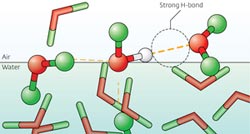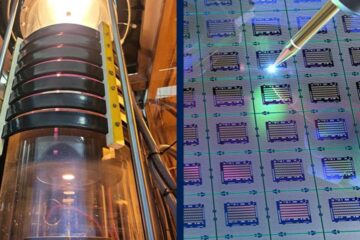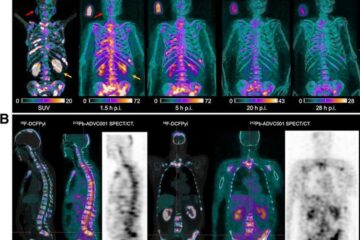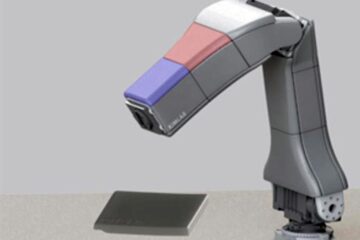Resolving controversy at the water’s edge

Figure 1: A ‘snapshot’ from a molecular dynamic simulation reveals that water molecules align at air–water interfaces as coordinated pairs linked by hydrogen bonds. Copyright : 2012 RIKEN<br>
Water (H2O) has a simple composition, but its dizzyingly interconnected hydrogen-bonded networks make structural characterizations challenging. In particular, the organization of water surfaces—a region critical to processes in cell biology and atmospheric chemistry—has caused profound disagreements among scientists.
Now, Tahei Tahara and colleagues from the RIKEN Advanced Science Institute in Wako, in collaboration with researchers in Japan and Europe, have uncovered the presence of strongly bonded water pairs at the air–water interface1, rather than previously hypothesized ‘ice-like’ surface structures.
Observing surface water molecules, just a few monolayers thick, requires special experimental techniques that prevent interference by more plentiful bulk particles. One such approach is called vibrational sum frequency generation (VSFG), a laser-based method that selectively vibrates interfacial molecules. Previous VSFG measurements of surface water showed two vibrations that resemble signals recorded from bulk ice and liquid water states. Some scientists have proposed that these vibrations correspond to a partially disordered mix of liquid and four-coordinated ice-like surface structures—a theory at odds with thermodynamic evidence.
Other VSFG experiments, however, have suggested that the two vibrations arise from one structure undergoing coupling interactions. To resolve this dispute, Tahara and colleagues turned to heterodyne-detected VSFG (HD-VSFG), a high-level spectroscopic method that detects how the phase of the vibrational signals shifts with respect to the incident laser beam—information that can pinpoint molecular orientation at interfaces.
The researchers then employed a trick using isotopes to account for coupling effects of water molecules: they added the deuterium (D)-bearing compounds HOD and D2O to pure water. By gradually diluting the number of oxygen–hydrogen (OH) bonds in the liquid, these isotopes suppress the interactions between the vibrational modes that normally occur. The remaining ‘stretching’ vibrations that extend and contract OH bonds then provide clear information about the interfacial water structure.
The team’s experiments revealed that as the isotopic dilution progressed, the two OH bands merged into a single peak, which is clear evidence of vibrational coupling within a single structure. After performing molecular dynamic simulations and comparing the results to the HD-VSFG data, a new picture emerged of the air–water interface (Fig. 1): the low-frequency OH vibrations were due to tightly joined pairs of liquid water molecules.
“We were wondering what kind of structure can have strong hydrogen-bonds other than ice at water surfaces,” says Tahara. “When our experiments and [co-author] Morita’s simulation answered the question, rather than surprise I felt that ‘This is it!’ because its structure is quite reasonable.”
The corresponding author for this highlight is based at the Molecular Spectroscopy Laboratory, RIKEN Advanced Science Institute
Media Contact
All latest news from the category: Life Sciences and Chemistry
Articles and reports from the Life Sciences and chemistry area deal with applied and basic research into modern biology, chemistry and human medicine.
Valuable information can be found on a range of life sciences fields including bacteriology, biochemistry, bionics, bioinformatics, biophysics, biotechnology, genetics, geobotany, human biology, marine biology, microbiology, molecular biology, cellular biology, zoology, bioinorganic chemistry, microchemistry and environmental chemistry.
Newest articles

Silicon Carbide Innovation Alliance to drive industrial-scale semiconductor work
Known for its ability to withstand extreme environments and high voltages, silicon carbide (SiC) is a semiconducting material made up of silicon and carbon atoms arranged into crystals that is…

New SPECT/CT technique shows impressive biomarker identification
…offers increased access for prostate cancer patients. A novel SPECT/CT acquisition method can accurately detect radiopharmaceutical biodistribution in a convenient manner for prostate cancer patients, opening the door for more…

How 3D printers can give robots a soft touch
Soft skin coverings and touch sensors have emerged as a promising feature for robots that are both safer and more intuitive for human interaction, but they are expensive and difficult…





















